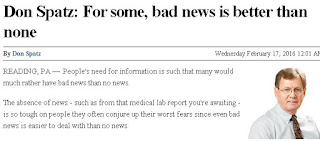[This story is not well
reported. I talked to no students, parents or teachers. Nevertheless, I wanted
to list some accomplishments since Superintendent Khalid Mumin took the job. If
he fails as quickly as past district leaders have, it will be a baseline for
future comparisons.]
by Steve Reinbrecht
Talk is cheap. In this
report, I’ll try to stay with what the Reading School District has actually
done since Superintendent Khalid Mumin took charge.
The Reading School District is
the most important institution in Berks County. It is struggling back from a long
history of nepotism, meddling school board members, incompetent administration
and public neglect.
It draws students from a
fifth of Berks’ population. It maintains 19 schools and serves about 17,300 children
– nearly one out of four of Berks’ public school students. The budget tops $200
million – most of it funded by state taxpayers. The district is Berks’ sixth-largest
employer, with about 2,000 employees.
After a string of quickly
departing or fired district superintendents, staff members from the Berks County Intermediate Unit, an educational-services agency, arrived in January 2014 to
straighten out the district’s accounting and finances. Two troublesome school
board directors resigned. Mumin took the job in June 2014, for $185,000 a year.
Mumin has worked to engage
students. For example, Mumin meets with a group of 40 high school students twice
a month to engage them about their concerns and ideas, School Board President Reading
School Board President Robin Costenbader-Jacobson said.
The meetings started in
November as a way for Mumin to talk directly with students and get to know
them.
“The agenda is theirs,” Mumin
said. “I’ve learned so much from them. I’ve gotten a lot back on that
investment.”
Recently, Mumin said, members
of the squad showed administrators unsecured areas in the high school that
students were entering for mischief. That led to new security gates. The
students got a look at the cost of the project to give them a sense of
risk-benefit decisions.
Mumin said the students
report about the meetings on social media.
The district plans to start a
similar squad at the Reading Intermediate High School in the spring.
To attract “lost students,” the
district started the Red Knight Learning Academy evening program at the
beginning of the school year. It’s designed for students who have dropped out and
would need only a few more credits to earn a high school diploma. Some students
finish the required work in only weeks. Then they can join graduation in June.
In a video about the program,
a student says she slacked off in school and gave up lacking only one credit to
graduate. Once she joined the evening program, she earned that in three weeks.
[The city’s only charter
school, I-LEAD, was started to educate such students. The district is in the
process of revoking I-LEAD’s charter.]
Reading School District
leaders have improved the curriculum. It’s refreshing to hear educators mention
curriculum before diving into finances. I’ve been at Reading School District
board meetings where the agenda was many pages of personnel actions and very few
about education. News stories have focused on finances.
In 2013, independent curriculum auditors called the district’s instructional curriculum “disparate,
almost random and incongruent.”
Planning guides were scarce,
their report said. Worksheets and other materials were frequently below the
correct grade level, did not align with state or federal standards, and lacked
challenging problem-solving and analytical thinking.
Now, at least, Mumin said, teachers
in different schools are following the same curriculum on a schedule. That’s
important in a district where children frequently switch schools.
“Teachers should be proud of
that. They worked hard.”
The district has started a new reading and writing program. On the 2015 PSSAs [state standardized state
tests], the district’s 13 elementary schools had an average of only 28 percent
of their third graders scoring proficient or
above in English test. The percentages in the schools ranged from 17 to 43
percent.
Students in grades 6-8
started the new language-arts program in the 2014-2015 school year. Students in
grades 4 and 5 began this year. Younger grades will be added next year.
Part of the program rewards students
for reading books at their level for at least 30 minutes a day. A handful of
students have read for more than 250 hours.
Mumin has developed ties with
other leaders. Before Mumin started, I’ve been told, it was hard to work with or
even contact district officials. Now access seems easier.
Anna Weitz, president of
Reading Area Community College, said Mumin is committed and open to seeking
community input.
“We are exploring ways we can
work together,” she wrote.
Penn State Berks Chancellor
R. Keith Hillkirk said he has met with Mumin several times, often about aproject at Glenside Elementary School, where teachers from both schools
collaborate. Mumin has been attending
quarterly Penn State Berks advisory board meetings, Hillkirk said.
Kevin Murphy, president of
the Berks County Community Foundation, a philanthropic organization, has had
“frequent and wide-ranging” conversations with Mumin. For example, the school district
accepted a foundation grant to hold the 2015 graduation in the Santander
Center. On the other hand, the district rejected an offer for mediation with
the I-LEAD charter school.
“We’ve discussed district
finances, board governance issues, curriculum and other issues,” Murphy wrote
in an e-mail.
Alvernia University has
started a program for teachers to earn certificates in teaching English as a
second language. About 40 Reading teachers have enrolled.
With United Way of Berks
County, the district is providing books in three barbershops and plans to
supply them throughout the city where children spend time with parents, such as
barbershops, rec centers, hairdressers, and coin laundries.
Costenbader-Jacobson said she
communicates daily with Mumin, discussing the strategic plan, curriculum,
communications, finances, operations and facilities.
The district’s statistics are
improving. Many Reading students don’t learn as much as counterparts in
non-urban districts. The district’s graduation rates and achievement-test
proficiency have been consistently near the bottom of the 500 or districts in
the state.
With changes in standardized
testing, it’s not valid to compare scores from year to year. Cheating and the
response to cheatings – not in Reading but in other cities – also have skewed
scores.
Nevertheless, the district’s
numbers are going in the right direction.
The district’s [4-year
cohort] graduation rate rose from 61 percent in 2012 to 71 percent in 2014. [A
department spokeswoman said the 2014-2015 figures are not available! As usual,
the state is maddeningly behind on basic data.] Mumin acknowledges that 90
percent would be better. The state average was 85 percent.
The number of
graduates rose from 716 to 742. Reading High School’s state performance profile
rose from 60.2 to 65.2 from 2014 to 2015.
The high school offered 10 AP
classes this year. Mumin wants to offer more. Wilson School District offers 20. Boyertown School District has
14.
In January, Reading High School [along
with Brandywine Heights Elementary School, Exeter’s Jacksonwald Elementary
School and Wilson’s Shiloh Hills Elementary School ] was named a Distinguished Title 1 School, based on improved test scores and other factors, by the
Pennsylvania Department of Education, Division of Federal Programs.
While student engagement is a
focus, Mumin acknowledged that the district needs to improve communications
with parents.
In the past, educators have
told me it’s difficult to attract parents to the city schools. Beside balancing
jobs and dependents, parents have been reluctant to come to buildings because they
lack faith in their English or have felt discriminated against.
Mumin says parents are
especially active on social media and spread news about the district among
themselves.
“It was like a great untapped
resource for us. Our parents are active, active, active on social media.”
Costenbader-Jacobson said
administrators have started a “#RSDproud” campaign “as a way for the community
to rally behind our students, staff and alumni.”
The site has posts but seems
a bit thin and district-driven. It will be interesting to see if more students,
teachers and parents start using it or if it fizzles.
Mumin’s Youtube video after a
fight in City Park in September got more than 4,400 hits.
Most, but not every, school
lists a “parent outreach assistant.” I e-mailed just one at random but got no
reply.
A couple of months after he
started the job, Mumin told me his ability to understand and connect with an
urban community such as Reading’s will help him succeed.
He grew up in Philadelphia,
missing 75 days in high school. He turned himself around, began his higher
education at a junior college and finished with a doctorate at the highly
selective University of Pennsylvania.
In any case, Costenbader-Jacobson
said, “Dr. Mumin understands and relates to our community. He visits the
schools daily and constantly talks with students, staff and parents.”
Mumin said he hasn’t had to
remove many people from the existing administration because it was a thin staff
when he arrived.
He has two vacancies: Chief instructional
services officer and the federal programs director.
He’s had to do some shifting
– for example, his chief of office of instructional services, Kandace A. Williams,
left for a new job at a school in Dubai, United Arab Emirates.
All the schools have a “full cadre”
of assistant principals, Mumin said.
The top issue right now is
getting good work contracts for all the staff, he said.
Reading teachers have been
working without a contract since Sept. 1, 2012. Wages and benefits have been
frozen.
“That’s Numero Uno. Being
able to compensate them fairly would enhance our buildings’ culture.”
Mitchell Hettinger, president
of the Reading Education Association – the teachers union – did not respond to
an e-mail.
Mumin also wants to find
space for new programs and get rid of trailer-classrooms at elementary schools.
For examples, he’d like more space
for AP classes and for English-language learners, acknowledging that newcomers from
the Dominican Republic, Mexico and many other countries arrive in the city with
almost no English and need a lot of help to succeed.
Improving safety is at the
top of his action plan, and is at the top of the list for parents, Mumin said.
In general, the district is headed in the right direction, with more openness, efforts to engage the community, and professional staff. And Mumin is being recognized for his role.
“The school district is
building momentum and morale under our new board's governance and Dr. Mumin’s
leadership,” Costenbader-Jacobson wrote.
A Facebook friend who watches
the city closely credits the improvement to: “The diversity of
the school board and within the administration. The coaches of the major sports
in the district reflect the student body who play those sports. Students are
engaging with teachers who are similar to them. It's just a great culture that
has been built from the top down. A lot of great energy.”
Newsworks.org called Mumin for his opinion on how the budget delay is affecting public schools.
Mumin said being invited to
Harrisburg recently is further sign of the district’s progress. He went to Harrisburg on Feb.
3 to watch Gov. Tom Wolf sign a bill postponing Keystone Exam requirements.
Mumin said he was humbled
that Wolf invited him to attend the bill signing postponing Keystone Exam
requirements.
"This illustrates the
momentum we have in the Reading School District. Pennsylvania lawmakers are
recognizing our successes, as well as understanding our challenges and finding
ways to address those."
The day before, the governor had visited Reading’s 10th and Green Elementary School to announce his proposed education
funding plan.
The district was wretchedly
managed and monitored for years, ripping off many taxpayers, children and Berks
County overall. Again and again, there have been new starts. We should keep a
close eye on this one.























